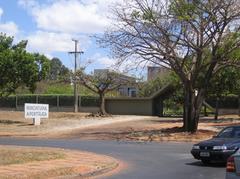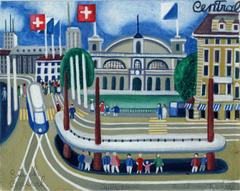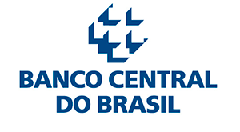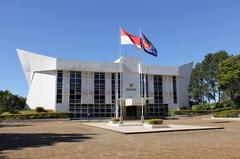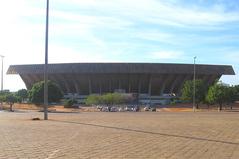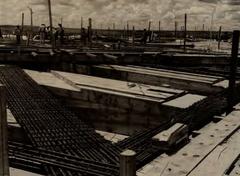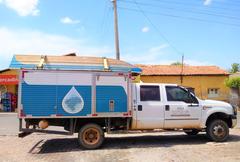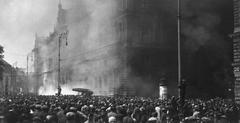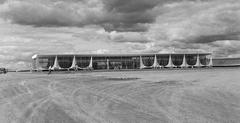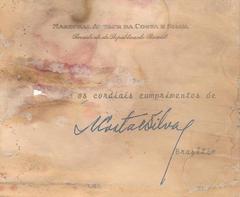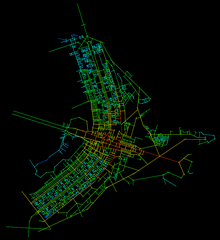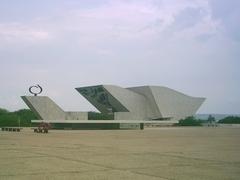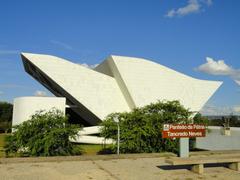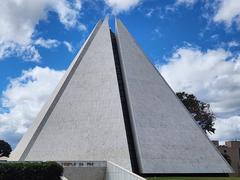Visiting Praça dos Três Poderes: Hours, Tickets, and Tips
Date: 31/07/2024
Introduction
Nestled in the heart of Brasília, Praça dos Três Poderes stands as a monumental testament to Brazil’s democratic ideals and architectural ingenuity. This iconic plaza, designed by the acclaimed architect Oscar Niemeyer and urban planner Lúcio Costa, encapsulates the harmonious coexistence of the country’s three branches of government—the Executive, Legislative, and Judiciary. The concept of Brasília as Brazil’s capital dates back to 1789, but it wasn’t until President Juscelino Kubitschek’s ambitious vision in 1956 that this dream became a reality (WikiArquitectura).
The plaza features some of the most significant architectural marvels in modern Brazilian history, including the Palácio do Planalto, the National Congress, and the Supreme Federal Court. Each of these structures not only symbolizes the balance of power but also serves as a visual representation of modern Brazilian architecture (Wikiwand). Beyond its architectural allure, Praça dos Três Poderes is rich in historical and cultural significance, hosting the world’s largest continuously flown flag and the Museum of the Foundation of Brasília. This comprehensive guide aims to provide visitors with all the essential information, from historical context and visiting hours to travel tips and nearby attractions, ensuring a well-rounded and enriching experience.
History and Significance
The Vision and Creation
The concept of Brasília as Brazil’s capital was envisioned long before its actual construction. The idea dates back to 1789 and was later enshrined in the 1891 Constitution. However, it was President Juscelino Kubitschek who, in 1956, propelled this vision into reality with his ambitious campaign promise of achieving “fifty years of progress in five.” The urban planning was entrusted to Lúcio Costa, while the architectural designs were the brainchild of Oscar Niemeyer (WikiArquitectura).
Architectural Significance
Praça dos Três Poderes, or Three Powers Plaza, is a monumental space designed to symbolize the harmonious coexistence of Brazil’s three branches of government: the Executive, Legislative, and Judiciary. The plaza is flanked by the Palácio do Planalto (presidential office), the National Congress, and the Supreme Federal Court (Wikiwand). This arrangement not only underscores the balance of power but also serves as a visual representation of modern Brazilian architecture.
Key Structures
Palácio do Planalto
The Palácio do Planalto, designed by Oscar Niemeyer, is the seat of the Executive branch. Construction began on July 10, 1958, and the building was completed in 1960. The structure is a rectangular glass box supported by a colonnade, reminiscent of a Greek temple. This design aims to project an image of modernity and simplicity, with a generous flat roof that protects the facades from direct sunlight (WikiArquitectura).
National Congress
The National Congress building is a striking example of modernist architecture. It comprises two office towers flanked by the Senate and the Chamber of Deputies. The building’s location at the end of Brasília’s monumental axis makes it an iconic symbol of the city and the nation. The design ensures that the structure is visible from distant viewpoints, reinforcing its significance (WikiArquitectura).
Supreme Federal Court
The Supreme Federal Court, like the Palácio do Planalto, was designed by Niemeyer and features a modernist style. The building is elevated on a platform, giving it an appearance of floating above the ground. This design choice, along with its symmetrical placement with respect to the plaza’s axis, enhances its visual impact and underscores its judicial authority (WikiArquitectura).
Symbolic Elements
The Brazilian Flag
One of the most notable features of Praça dos Três Poderes is the Brazilian flag, which is the largest in the world to be flown continuously. Weighing approximately 600 kilograms (1300 pounds), the flag is changed monthly in a ceremonial event attended by the Presidential Guard Battalion, Independence Dragoons, and sometimes the President of Brazil (Wikiwand).
Museum of the Foundation of Brasília
Located at the center of the plaza, just behind the National Congress building, is the Museum of the Foundation of Brasília. This museum is the only element added to the original project and serves as a repository of the city’s history and development (WikiArquitectura).
Visitor Information
Tickets and Opening Hours
Praça dos Três Poderes is open to the public daily from 9:00 AM to 6:00 PM. Admission is free, allowing visitors to explore the plaza and its surrounding structures at no cost. For more detailed information, visitors can refer to the official website of Brasília’s cultural sites.
Travel Tips
The best times to visit Praça dos Três Poderes are early mornings or late afternoons when the light is perfect for photography, and the temperatures are more comfortable. The plaza is easily accessible by public transportation, and there are ample parking spaces for those driving.
Nearby Attractions
When visiting Praça dos Três Poderes, consider exploring nearby attractions such as the Itamaraty Palace, the Cathedral of Brasília, and the JK Memorial. These sites offer additional insights into Brasília’s rich history and architectural brilliance.
Accessibility
Praça dos Três Poderes is equipped with ramps and elevators, making it accessible for visitors with disabilities. Additionally, there are informative signs in Braille and audio-guided tours available.
Special Sections
Guided Tours
Guided tours of Praça dos Três Poderes are available and provide in-depth information about the history and significance of the plaza and its structures. These tours can be booked through the official tourism website of Brasília.
Photographic Spots
For photography enthusiasts, the best spots include the central axis of the plaza, the reflecting pools, and the elevated platforms around the Supreme Federal Court. These spots offer stunning views and angles of the iconic buildings.
Historical Events
Inauguration
The plaza was inaugurated on April 21, 1960, marking the official opening of Brasília as the new capital of Brazil. This event was a significant milestone in Brazilian history, symbolizing the country’s aspirations for modernization and progress (WikiArquitectura).
Recent Incidents
On January 8, 2023, Praça dos Três Poderes was the site of a significant political event when supporters of former President Jair Bolsonaro invaded the plaza. This incident highlighted the plaza’s ongoing relevance as a focal point for political expression and activity in Brazil (Wikiwand).
Cultural and Political Significance
Praça dos Três Poderes is not just an architectural marvel but also a symbol of Brazil’s democratic values. The plaza’s design and the buildings surrounding it reflect the country’s commitment to transparency, balance of power, and modernity. It serves as a constant reminder of the principles upon which the Brazilian government is founded.
FAQ
What are the visiting hours for Praça dos Três Poderes?
Praça dos Três Poderes is open to the public daily from 9:00 AM to 6:00 PM.
How much are tickets for Praça dos Três Poderes?
Admission to Praça dos Três Poderes is free.
Are there guided tours available?
Yes, guided tours are available and can be booked through the official tourism website of Brasília.
Conclusion
Praça dos Três Poderes is not just a symbol of Brazil’s democratic values but also a must-visit destination for anyone interested in the country’s history and culture. Plan your visit today to witness the architectural brilliance and symbolic importance of this iconic space.
